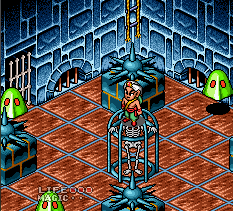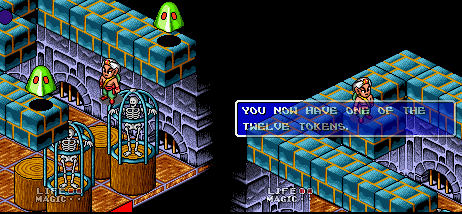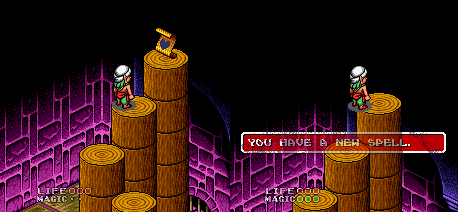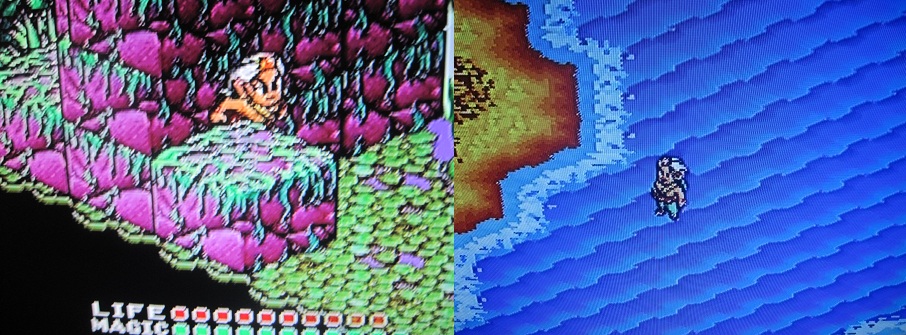Rewind. I was at an EB Games that had recently opened. They had a game I had always wanted – Equinox. However, at the time I had already spent my cash and didn’t have my debit. I was determined to go back and buy it, but when I did – it was gone. Denied. Never to see it crop up in the wild again. But I’ve rectified that error, and I recently procured a copy for myself.
I was spurned on by my completion of Solstice, the “skeleton in my gaming closet.” It just so happens that Equinox is Solstice 2. A proper sequel featuring Shadax’s son with some solid talent behind it, designed by the Pickford brothers with both Tim and Geoff Follin as composers. And given my love for Solstice, this was a natural choice for me. Does Equinox hold up to its predecessor?

Equinox and Solstice are different beasts hewn from the same stone, really. Solstice is much more localized. It takes place in one single dungeon and is completable in roughly a half hour once you become accustomed to the pitfalls of Kastlerock. Shadax cannot attack directly, so there is a very heavy emphasis on puzzle solving. Equinox retains the puzzle solving and high dexterity traps. However, it also adds a combat edge, multiple dungeons, and a save feature. Where Solstice is a one sitting game that focuses on deep mastery of a location, Equinox is a multiple sitting game with an emphasis on versatility and exploration.

Equinox stars Glendaal, the son of Shadax from Solstice. When Shadax leaves to give his wizardly tutelage to a woman named Sonia, he is captured and the world is thrown into turmoil. So it’s up to Gendaal to defeat the evil witch Sonia and restore peace. He’s a novice wizard and starts out quite weak, but will grow significantly throughout the journey. Because adventure’s in the air, it must be the season of the Witch.

Like Solstice, Equinox holds an isometric viewpoint. It’s an isometric action adventure puzzle game, its genre is a mouthful. There are eight large dungeons each containing twelve tokens, a weapon, and a spell. Collecting twelve tokens allows you to summon a boss in the boss room, and defeating said boss allows passage to a new land. It will take some thought to solve the puzzles of these dungeons, and just as many of them will require dexterity and the ability to process the spatial peculiarities of the isometric view.
Dungeon progression is fairly adept. Each dungeon has its own gimmick, a play on the established rules of previous dungeons that lend a unique flavour. Many of the dungeons introduce new elements as well. Blocks with mystic force that act as conveyers, some that sink under your weight, or turn invisible, or move, etc. The blocks look no different from one another so there’s a bit of predictive playing here. It’s a very Legend of Zelda quality of “testing the waters” at times. While this may turn some people off, I found it exciting and it made even the most simple looking puzzles potentially deadly. This even includes invisible doors like in the first LoZ, so wall humping every room soon becomes ritual. There are certain “tells” to these doors though, and you’ll get the hang of it. This kind of dungeon crawling doesn’t appeal to everyone but I ate it right up.
As ubiquitous as the blocks in the dungeons are the various enemy types. Enemy strength is determined by a palette swapped caste, again akin to the Legend of Zelda. Each enemy type has its owns strategy, and every one of them are lethal to the touch. Enemies can be defeated with your weapon, but some are critical components to puzzle solving. For instance, push a box on top of an enemy to catch a ride Solstice style. Enemies will only be permanently gone from a room if you destroy them all and collect any items present (including anything they drop). Sometimes it helps to keep enemies alive just to come back for their drop later!
Glendaal can expand his power gradually and greatly in this game. Each weapon is a thrown blade, but also has its own properties, differing in strength, speed, and onscreen projectiles. For instance, the scimitar will let Glendaal toss three scimitars forward in rapid succession. The twin knife, on the other hand, will only allow two to go forward but also one tossed behind him – useful for rooms that start with an enemy in hot pursuit!

He can also find magic spell scrolls. These spells range from very useful to very situational. Unlike Shadax who had to use draughts of potions to use magic, Glendaal has a dedicated magic bar with each spell using a set amount of “MP.” Picking up a scroll also increase this bar by one whole pellet.

You have a health bar as well. Or rather, a bar that represents your available “lives.” Each hit “kills” Glendaal, removing half of a life pellet and resetting the current room to the state it was in when you entered it. When you get a new weapon, you can increase your health bar by defeating a Troll on the world map after you’ve gained a new weapon.
That’s another change. With multiple dungeons, there is a world map. This map is fully rotatable and contains all of the entrances to the dungeons (some have multiple) and the trolls and bats that try to force you into a battle scene, Zelda II style. These are giant miniboss creatures that are imposing at first, but pretty exploitable once you learn how to deal with them. The bat monsters, for instance, always drop a potion so they are a good source of magic power if you’re running low.

There are bridges on the overworld that are blocked by the ghost of a boss monster. You must locate their bodies in the underworld and destroy them. Bosses are large creatures that can soak up a lot of damage. They are, naturally, very aggressive but subscribe to patterns that make them more than manageable once you learn them. Defeating a boss increases both your health and magic, and eliminates their spirit’s tie to the world, allowing passage into new realms. So while progression and growth are more or less set, it’s gradual and feels right and accomplished.

This is all well and good, but Equinox does have an ugly side. Namely: glitches. There are a couple of game breaking glitches and you should read up on these if you decide to play the game. ALWAYS back-up your file before a new dungeon, and save often. I’ve had a lot of graphical glitches and errors, understandable given the aesthetic choice. I’ve also been pushing a block only to move through that block and into some spikes. I’ve been stuck between blocks, and stuck in the middle of the ocean. Pushing stacks of movable blocks seems to be glitch at times, perhaps as multiple movable objects interact with the world around them. The glitches are unfortunate, yes. But don’t let them ruin an otherwise amazing game. I’m not an apologist for the glitches, but I will say that they were not a major a deterrent in my enjoyment of this game.

I guess it comes down to Equinox being a fairly ambitious game with an unorthodox style. While isometric games were not unheard of by this time, they do face their own set of challenges. Not just in terms of collisions, but in design as well. Even constructing the dungeons to be intuitive to players would be a trial. But Equinox is very well constructed, and you can tell the crew had fun with the viewpoint and the optical illusions it can create!
Equinox is a beautiful game. Sprites are large and colorful and well drawn. Everything is animated well, and every dungeon has its own unique flavour and motif. The joint Follin music talent behind Equinox is terrific. Haunting songs give way to lonely ambiance and back to music again. It works surprisingly well, and allows you to appreciate the feeling of each dungeon as well as preventing the actual musical pieces from becoming overplayed and droning. Really, Equinox is quite lovely. A treat.
Sure, it’s a little rough in places but the truth of the matter is that it’s an excellent game that has so much to offer. It’s a smart game, progression feels real and rewarding. It’s not a game for the faint of heart, dungeon crawling can be arcane and punishing. What is it then? It’s a game for people who like great, challenging SNES games. It’s a shame that, to my knowledge, Equinox never did receive a sequel. A Solstice 3 could be breathtaking, and many of the pratfalls of Equinox could be overcome. But what we do have is Equinox, and if that’s the swan song for Solstice then it’s a seriously enchanting one. This game is cerebral, intuitive, and reflex demanding. And that’s what I like. You’ve got to step to it.

“wall humping” lol, though really I don’t like when games include it.
Yeah, this is more accessiable than the first. Like most SNES games compared to NES, they eradicated the design flaw of ‘no save/play in one sitting/start from first stage if you get game over’ though still challenging from the sounds of it.
The glitches suck, but at least they didn’t affect you greatly. I’ll make sure to try it.
I’m used to it. Wall humping is the term I’ve used for this since forever, whether it’s checking _everything_ in an RPG to hugging _every_ wall in a game like this. Maybe I’m just conditioned for it, but I’ve never minded.
With NES I guess a lot of games were under an arcade mentality for a while. Batteries may not have always been an affordable option and passwords can get really overbearing (see: Faxanadu). Maybe I’m spoiled by games where you can suspend _anywhere_ and where this is the norm, but I do appreciate it. You can still be generous with saving while maintaining a sense of consequence.
With Solstice, it makes sense in the end because that game is so compact. But even that could have benefited from a simple password or save room even if the save was erased when you resumed (like modern quicksaves).
Shame about the glitches (obvs) but sounds a very worthy sequel especially with the more expansive world/setting.
I think I’ve already asked you about the music and you said it was good, but where it’s not so much of a talking point here I don’t suppose it’s as much a standout feature as it was in Solstice. TBH the Follins best work seems to be 8-bit anyway as they deeply impress with their achievements within those tighter technical constraints 🙂
Glitchy teleporting reminds me of playing Willow on NES… some random warp thingie… don’t know if it was a Game Genie thing or a Classified Info thing… that was a solid game too, wonder what a 16-bit followup to that one would’a been like 🙂
I wouldn’t say the music is underwhelming by any stretch of the imagination, though I will admit that I prefer Tim’s c64 and NES stuff. The music is quite nice, it’s just that it tried something very different from Solstice.
As for a 16 bit Willow, well it would have had to have been a simultaneous release since there’s only been one Willow movie. Or maybe an enhanced version or different studio’s take on it. Of course, like any 80’s property there are talks of a sequel every now and then so maybe you will see a new Willow game eventually (because every movie gets games).
I’m sure, however, that an SNES Willow would have been leagues iller than the SNES LotR!